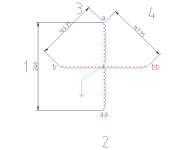- Location
- Wisconsin
- Occupation
- PE (Retired) - Power Systems
I count phases by the number of L-L voltages, so I have no problem with this terminology.In the same way that the diameter of a 1" pipe is not 1", the 2 out of 3 situation is 'nominally' single phase.
It isn't really single phase, but it is used like single phase and is called single phase.
Jon



